
Have you ever noticed white dots on your Samsung TV screen? If so, you’re not alone. This article will help you understand the Samsung TV white dots on screen issue and provide valuable information on identifying, troubleshooting, and potentially fixing this problem.
White dots on a Samsung TV screen have become a common issue for many users, causing frustration and concern about the quality of their television. Understanding the potential causes of these white dots is the first step in addressing the issue effectively.
There are several factors that could lead to white dots appearing on your Samsung TV screen. From manufacturing defects to environmental factors, it’s important to be aware of what might be causing this issue in order to find the best solution.
Identifying the presence of white dots on your Samsung TV is crucial for resolving the problem. By learning how to differentiate these white dots from other screen issues or imperfections, you can take necessary steps to address them effectively.
In this article, we will explore various troubleshooting steps that can help you eliminate or reduce the appearance of white dots on your Samsung TV screen. Whether it’s through DIY fixes or seeking professional help, there are ways to tackle this issue and enjoy clear viewing once again.
Causes of White Dots on Samsung TV Screen
Manufacturing Defects
One of the most common causes of white dots on Samsung TV screens is manufacturing defects. These defects can include problems with the DLP chip, which is responsible for producing the images on the screen. If there are issues with the DLP chip, it can result in white or black dots appearing on the screen.
Normal Wear and Tear
Over time, Samsung TVs may experience normal wear and tear, which can lead to the development of white dots on the screen. This can happen if there is damage to the DLP chip or other internal components of the TV. Additionally, dust buildup inside the TV can also contribute to white dots appearing on the screen.
Heat and Environmental Factors
Excessive heat can also contribute to white dots appearing on a Samsung TV screen. If a TV is exposed to high temperatures for an extended period of time, it can cause damage to internal components, leading to the appearance of white dots. Similarly, environmental factors such as humidity or fluctuations in temperature can also impact the performance of a Samsung TV and result in white dot issues.
Electrical Problems
Issues with electrical components within the Samsung TV can also be a cause of white dots on the screen. This could be related to power surges or fluctuations in voltage, which can damage internal components and lead to display issues like white dots.
Age of TV
As a Samsung TV ages, its internal components may start to deteriorate, leading to potential issues such as white dots on the screen. The aging process can affect various parts of the TV, including the DLP chip and other display-related components.
How to Identify the White Dots on Your Samsung TV
When trying to identify the white dots on your Samsung TV, it’s important to closely examine the screen to determine the extent of the issue. Here are some steps you can take to properly identify and assess the white dots:
1. Check for Multiple White Dots: Turn on your Samsung TV and observe the screen for any small, bright white spots that appear consistently across different content. These may be particularly noticeable against dark backgrounds.
2. Determine the Size and Distribution: Take note of the size and distribution of the white dots. Are they concentrated in a specific area of the screen, or are they scattered throughout? Measuring their size and identifying how many there are can help in assessing the severity of the problem.
3. Look for Pixelation or Distortion: Pay attention to any pixelation or distortion around the white dots, as this can indicate a more significant underlying issue with the display.
4. Consider Viewing Angles: Move around your TV to view it from different angles. The presence of white dots may vary depending on your line of sight, so checking from various positions can help you understand their visibility.
5. Document Your Findings: To effectively communicate with a professional technician or customer service representative, consider taking photos or making notes about what you’ve observed. This information can be helpful when seeking assistance with troubleshooting or repair.
By following these steps, you can accurately identify and describe the white dot issue on your Samsung TV, which is essential for determining appropriate next steps in addressing this display problem caused by issues like dead pixels or faulty LED lights.
Steps to Troubleshoot White Dots Issue on Samsung TV
Check for Firmware Updates
One of the first steps to troubleshoot white dots on your Samsung TV screen is to check for any available firmware updates. Oftentimes, manufacturers release firmware updates to address known issues, including the white dot problem. To do this, navigate to your TV’s settings menu and look for the “Software Update” option. If there are any updates available, be sure to download and install them.
Inspect the Connections
Another important troubleshooting step is to inspect the connections between your Samsung TV and any external devices, such as cable boxes, gaming consoles, or streaming devices. Loose or faulty connections can sometimes cause display issues, including the appearance of white dots on the screen. Ensure that all cables are securely plugged in and that there are no signs of damage.
Run Built-in Diagnostic Tools
Many Samsung TVs come equipped with built-in diagnostic tools that can help identify and troubleshoot display issues. These tools can often be accessed through the TV’s settings menu or via a specific button sequence on the remote control. Running a diagnostic test can provide valuable insight into any potential hardware problems that may be causing the white dots to appear on the screen.
Reset Your TV Settings
If you’re still experiencing white dot issues after checking for updates and inspecting connections, try resetting your TV’s settings to their factory defaults. This can help eliminate any potential software glitches or incorrect display settings that may be contributing to the problem. Keep in mind that performing a reset will erase any custom settings or preferences you have set up on your TV.
Contact Samsung Support
If none of the above troubleshooting steps resolve the issue with white dots on your Samsung TV screen, it may be time to contact Samsung support for further assistance. They can provide additional guidance and potentially offer a solution based on your specific TV model and issue at hand. Be sure to have your TV’s model number and serial number handy when reaching out to support for a more efficient process.
By following these troubleshooting steps, you can effectively address the issue of white dots appearing on your Samsung TV screen and potentially resolve it without the need for professional intervention.
Common DIY Fixes for White Dots on Samsung TV Screen
If you have noticed white dots on your Samsung TV screen, there are a few DIY fixes that you can try before seeking professional help. These fixes may help resolve the issue and improve the overall viewing experience of your television.
One common DIY fix for white dots on a Samsung TV screen is to gently clean the affected area with a soft, microfiber cloth. Dust and debris can sometimes accumulate on the screen, causing the appearance of white dots. Gently wipe the affected area in a circular motion to remove any particles that may be causing the problem.

Another DIY fix is to check the connections between your devices and the TV. Loose or faulty connections can sometimes lead to display issues such as white dots on the screen. Ensure that all cables are securely connected and that there are no visible signs of damage.
If cleaning and checking connections do not resolve the issue, you can try power cycling your Samsung TV. Simply unplug the television from the power source, wait for a few minutes, and then plug it back in. This process can sometimes reset any minor display issues, including white dots.
Additionally, updating the firmware of your Samsung TV may also help in resolving white dot issues. Manufacturers often release software updates to address known problems and improve overall performance. Check for any available updates through the TV settings menu or visit Samsung’s official website for instructions on how to update your TV’s firmware.
Finally, if none of these DIY fixes work and you continue to see white dots on your Samsung TV screen, it may be time to seek professional help or contact Samsung customer support for further assistance.
| DIY Fix | Description |
|---|---|
| Cleaning with a Microfiber Cloth | Gently wipe affected area in circular motion |
| Check Connections | Ensure all cables are securely connected |
| Power Cycling | Unplug TV from power source and plug back in after a few minutes |
| Update Firmware | Check for available updates through settings menu or manufacturer’s website |
When to Seek Professional Help for White Dots on Samsung TV
If you have identified white dots on your Samsung TV screen and have attempted basic troubleshooting methods without success, it may be time to seek professional help. While many issues can be resolved through DIY fixes, there are instances where a professional technician is needed to address the problem effectively.
One common cause of white dots on a Samsung TV screen is a malfunctioning DLP chip. This specialized component is responsible for producing the images on the screen, and if it becomes faulty, it can result in the appearance of white dots. Replacing a DLP chip requires technical expertise and should be done by a qualified technician to ensure proper installation and calibration.
Another situation that may call for professional assistance is if the issue is determined to be related to the TV’s internal circuitry or wiring. In this case, attempting repairs without the necessary knowledge and experience can lead to further damage to the TV. Professional technicians have the skills and tools required to diagnose and repair complex internal issues with precision.
Furthermore, seeking professional help is advisable if you are unsure about the cause of the white dots or if multiple troubleshooting attempts have been unsuccessful. A trained technician will be able to conduct a comprehensive assessment of your Samsung TV, identify any underlying issues, and recommend appropriate solutions.
In some cases, seeking professional help for white dots on your Samsung TV may also be covered by warranty or extended service plans. It’s important to review your warranty coverage or service agreement to determine if professional assistance is included at no extra cost.

Lastly, if you notice any sudden changes in your TV’s performance or if the presence of white dots is accompanied by other abnormal symptoms such as flickering or color distortion, it’s crucial to consult a professional technician promptly to prevent potential safety hazards and further damage to your TV.
| Aspect | Details |
|---|---|
| Possible Causes | DLP chip malfunction, internal circuitry issues |
| Warranty Coverage | Review warranty or service agreement for coverage |
| Symptoms | Changes in performance or additional abnormalities require urgent attention |
Preventive Measures to Avoid White Dots on Samsung TV
If you are a Samsung TV owner, you may be concerned about the possibility of encountering the dreaded white dots issue on your screen. While it can be frustrating to deal with, there are preventive measures that you can take to minimize the risk of experiencing this problem. By being proactive in your approach, you can potentially avoid the headache of dealing with white dots on your Samsung TV screen.
Here are some preventive measures to consider:
1. Keep Your TV Clean: Dust and dirt can accumulate on your TV screen and contribute to potential issues such as white dots. Regularly dusting your television with a soft, microfiber cloth can help prevent debris from building up and causing display problems.
2. Proper Ventilation: Overheating can also lead to display problems on your Samsung TV, including the appearance of white dots. Ensure that your television has proper ventilation and is not placed in an area where it can easily overheat.
3. Avoid Physical Damage: Accidental knocks or impacts to your TV screen can result in damage that may manifest as white dots over time. Be mindful of the placement of your television and take precautions to minimize the risk of physical damage.
4. Power Surges: Electrical issues can also impact the performance of your Samsung TV. Investing in a high-quality surge protector can help safeguard your television from power surges that could potentially lead to display problems.
5. Software Updates: Keeping your Samsung TV’s software up to date is important for optimizing its performance and addressing any potential issues that may arise, including white dots on the screen.
By taking these preventive measures, you can reduce the likelihood of encountering white dots on your Samsung TV screen and enjoy a more seamless viewing experience.
In addition to these preventive measures, it’s important to stay informed about any developments in technology or updates from Samsung that specifically address the issue of white dots on their TVs. As technology continues to advance, there may be new features or improvements in future Samsung TV models aimed at minimizing or eliminating this issue altogether. Stay tuned for updates from Samsung regarding their efforts to address white dot problems on their televisions.
Comparison of Samsung TV Models and White Dots Issues
When it comes to Samsung TV models, there are various differences that consumers should consider, including the occurrence of white dots on the screen. Different Samsung TV models may be more prone to experiencing this issue, and it’s important for consumers to understand how each model compares in this regard.
One of the factors that can contribute to the occurrence of white dots on a Samsung TV screen is the quality of the internal components. Cheaper or lower-end models may be more susceptible to developing white dots due to subpar manufacturing materials or processes. On the other hand, higher-end models with better quality components may be less likely to experience this issue.
Another aspect to consider when comparing Samsung TV models is the frequency and severity of white dot occurrences. While some models may have occasional and minor instances of white dots on the screen, others might have more frequent and noticeable occurrences. This can greatly impact a consumer’s overall satisfaction with their TV purchase.
Additionally, the resolution and display technology used in different Samsung TV models can affect how prominently white dots appear on the screen. Higher resolution and advanced display technologies may help minimize the visibility of white dots, while lower resolution screens may make them more apparent.
It’s also crucial for consumers to gather information about warranty coverage and customer support for each Samsung TV model they are considering. Some models may come with better warranty options or dedicated customer support for addressing issues such as white dots on the screen, providing added peace of mind for purchasers.
Ultimately, when comparing Samsung TV models and their propensity for experiencing white dots on the screen, consumers should take into account various factors such as component quality, frequency of occurrence, display technology, and after-purchase support. By considering these factors carefully, consumers can make more informed decisions when selecting a Samsung TV model that aligns with their preferences and needs while minimizing potential issues like white dots on the screen.
Future Developments in Samsung TV Technology to Address White Dots Issue
In conclusion, the issue of white dots on Samsung TV screens is a common concern among consumers. Understanding the causes and identifying these white dots is the first step in addressing the problem. While there are DIY fixes that can help alleviate the issue temporarily, seeking professional help may be necessary for a more permanent solution.
As technology continues to evolve, it is expected that Samsung will develop new technologies and innovations to address the white dots issue. With advancements in display technology and manufacturing processes, future models of Samsung TVs may be less prone to developing white dots on the screen.
It is important for consumers to stay informed about preventive measures to avoid or minimize the occurrence of white dots on their Samsung TVs. Proper maintenance and care can go a long way in ensuring the longevity of your TV screen.
When comparing different models of Samsung TVs, it is crucial to consider any reported issues with white dots on the screen. Researching and understanding how different models fare when it comes to this issue can help consumers make an informed decision when purchasing a new TV.






